Implants are the new ‘it’ in dentistry. Not only does an implant make your appearance 10/10, it also feels like a real tooth.
They are comfortable, durable and the most convenient dental prosthesis ever made.
If you have just gotten an extraction done and are contemplating on options to replace the empty space, implant is definitely your answer.
However, if your dentist hasn’t already mentioned to you the different types of tooth implants, don’t worry as this article will answer all your questions.
What Is A Dental Implant?
A dental implant is a permanent dental prosthesis that is literally drilled inside your bone surgically. It looks like a screw and works like a root within your bone.
Over it, a crown, bridge, denture or even a facial prosthesis can be attached. There are three types of dental implant:
The endosteal implants are placed directly into the bone.
The sub periosteal implants are placed under the gum but above the jawline.
A third type which is different from the conventional implants include the zygomatic implants. They are only used when the quality or quantity of the bone in the upper jaw is inadequate.
What Are Tooth Implants Made Of?
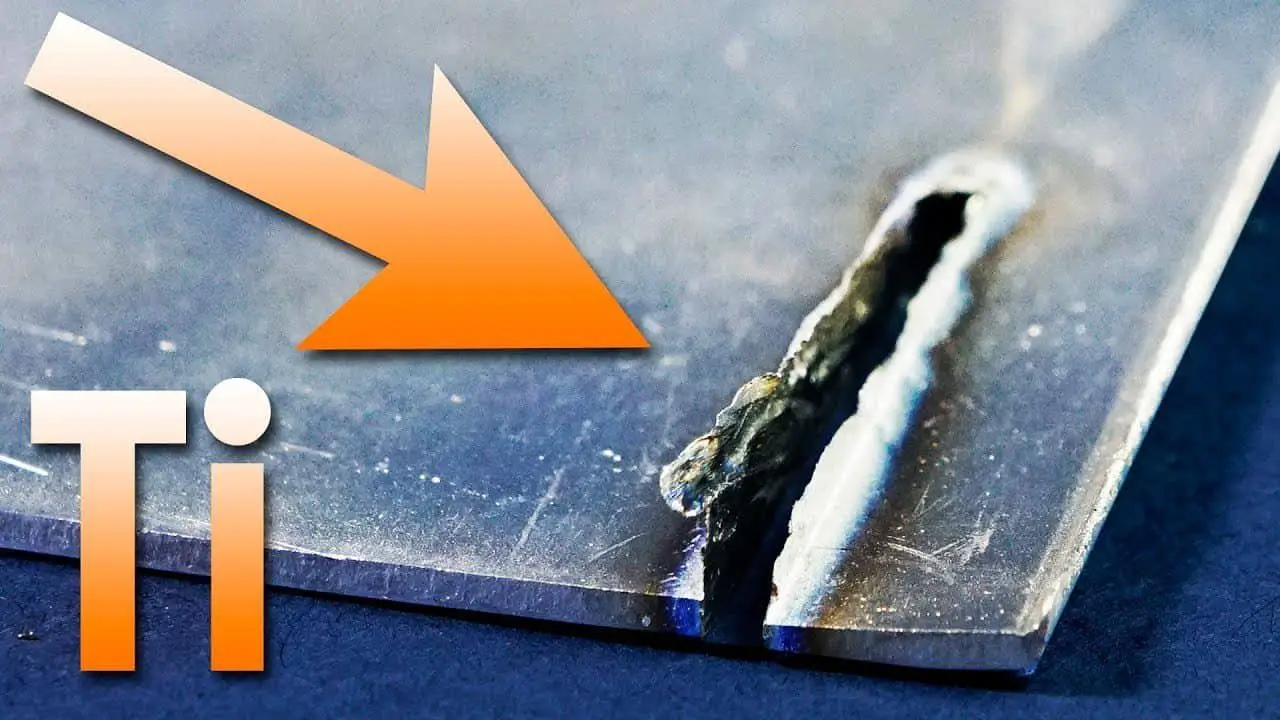
I am sure that having to get a screw like thing drilled inside your mouth/bone is pretty dreadful. You are constantly wondering about the side effects which may even affect your decision on getting a dental implant.
Therefore, it’s important to know what material an implant is made of.
An implant is made up of a highly biocompatible material
And that material is *drum roll*, Titanium!
Another material that has finally made an entry to the dental implant world is Zirconia and the two of them are in close competition.
Pros And Cons Of Titanium Dental Implants
Titanium is the most common type of material used in dental implants and has a 95% success rate. It is strong and durable, yet lightweight and can last for more than 30 years.
That being said, there are still some downsides to it that are worth mentioning. Despite titanium being a compatible implant material; it has been found in several research papers to cause several unexplained medical conditions.
Putting it in easier words, when the titanium is drilled inside the bone, the particles of the material dissolve into the surrounding bone. As we all know; our bodies have a coping mechanism whenever they are exposed to any foreign body.
Hence, in some individuals whose bodies are already subjected to autoimmunity aka systematic immune responses against the body’s healthy cells and tissues, getting a titanium dental implant can lead to ‘silent inflammation’ of the bone.
By that we mean that you will not notice any apparent change on the site or the surrounding of the implant. But, as your immune system is constantly stimulated, there is a chance of quietly losing all the bone around the implant.
Apart from that, as your immune system is constantly considering titanium a threat, it may also lead you towards acquiring chronic diseases which simply means that the disease is persistent or long lasting in its effects.
Therefore, it is important to get a full checkup of your immune system before deciding to get a titanium dental implant.
If you are someone who has a lot of allergies or you want to stay on the safe side, it’s a great idea to take the MELISA test.
This is a blood test which identifies and diagnoses metal allergies.
If you find out that you are allergic to Nickel, a titanium implant is still a big no for you as it’s made of an alloy that includes traces of nickel.
Pros And Cons Of Zirconia Dental Implants
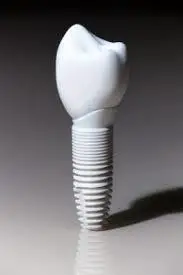
Zirconia is a metal free crystal material that has finally started to make its way in the dental world. Even though there is still a long way to go for zirconia implants to take over the titanium ones, it has plenty of benefits.
With zirconia implants, you don’t need to worry about metal allergies or foul metallic taste in your mouth. Apart from that, zirconia as opposed to titanium implants which are inserted into your bone with three parts, is inserted with one simple part.
That means shorter surgery. Along with that, zirconia is highly aesthetic.
However, despite of all these amazing benefits, the dentists usually choose to go with titanium implants, the reason being the cost of zirconia.
They are much more expensive than titanium and are not yet proven to be as long lasting as titanium either.
As most people do not have titanium allergies and the metal particles can only lead to unexplained diseases in people with autoimmune diseases, titanium is still and maybe always will be the winner!
Different Types Of Dental Implants
Endosteal Implants
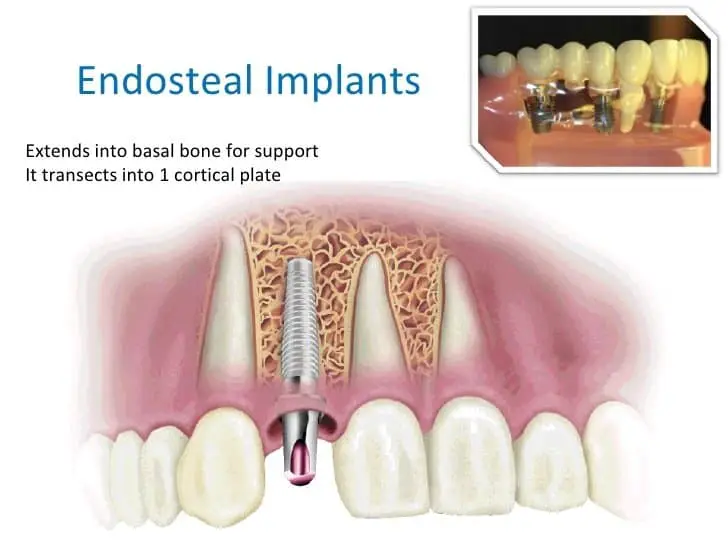
Being the most common type of implant used in dentistry, an endosteal implant is placed directly into your jaw bone.
Implants are surgically put inside your mouth so it is crucial to completely numb the site.
Your doctor will first give you anesthesia to completely numb the desired area. It is also possible that they decide to do your procedure under general anesthesia.
Before putting an endosteal implant, the surgeon will make a cut on your gum or gingiva at the desired location. Once the cut has been made, they will use the periosteal elevator to smoothly and carefully separate the gingiva from the bone, thereby exposing the alveolar bone.
Once that has been carefully done, they will examine your bone and look for any roughness or bulges. If any of this is seen, then they will use a slow speed drill to smoothen your bone as desired.
If the dentist is sure that there is no need to smoothen the bone and the evaluation of the implant site is seldom needed, they may opt for an easier option of separating the gingiva from the bone.
What they will do instead is use a circular tissue punch in order to remove the gum tissue. This is a much less invasive procedure but requires a great deal of expertise.
Moving on to the next step, once the dentist is ready to put the implant in, they will identify the position of the implant. As soon as they are sure where the implant should be put, they will make a small hole at the location with a small round dental bur.
Following that, they will use a series of drills, each with an increasing diameter to create a hole where the implant would later be placed.
Before we talk about how the endosteal implants are placed within the space, its important to know that they are further classified into:
Cylinder/screw and blade type.
The only difference between the two is that a cylinder or screw like implant only consists of one abutment which is the element connecting the other two components, cylinder and screw of the implant.
In case of the blade type, there are two or more abutments present.
Coming back to the placement of an endosteal implant, it may be a one-step or a two-step process depending on your health and aesthetic concerns. As the two-step process is more common, we shall go into its detail.
In the two-step process, first a cover screw is placed inside the bone which covers the implant. After that, a healing cap is placed and the gum is sutured.
This is an important step as for an appropriate period of time, i.e. 3 to 6 months, the bone is allowed to grow around the implant, a process called osteointegration.
Once the doctor has figured out through follow-up appointments and X-Rays that the bone has healed completely, they will conduct a second surgery and place an abutment upon which the artificial tooth or crown will be placed.
All of the things above being said, an implant is not a cheap option. It may cost you somewhere between $1500 and $6000, but it is definitely worth it!
Subperiosteal Implant
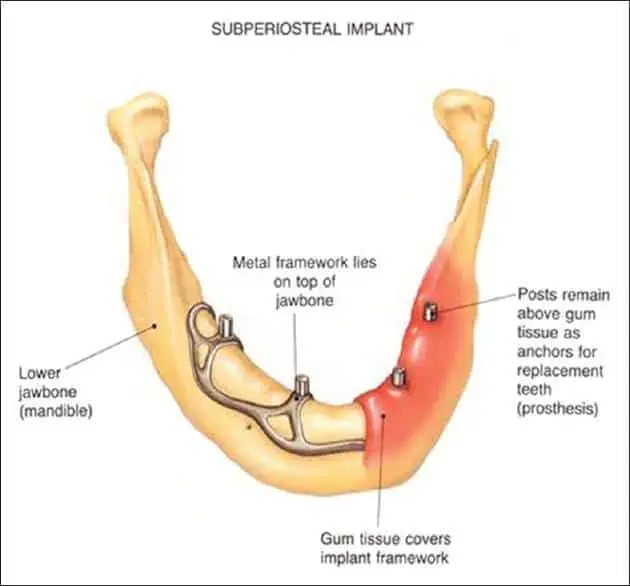
As already mentioned above, a sub periosteal implant is attached over the bone and not drilled inside it.
How it’s differentiated from an endosteal implant is that during surgery, even though the gum and the bone are separated from each other by surgically removing the gum away, the implant is basically a metal frame that covers the bone.
But before you think that this seems simpler than an endosteal implant, let me tell you that it takes two surgeries to get a sub-periosteal implant.
In the first surgery, once the bone is exposed, the dentist takes an impression of the bone, which is then sent to the lab and a frame is made over it. This may take from a few days to weeks to get done.
Once the metal frame is back from the lab, the dentist will prepare for a second surgery. In this surgery, they cut open the gums of the desired location to insert the metal frame.
The gums are then sutured back while making sure that the posts attached on the metal frame remain above the gum tissue. The purpose of these posts is to provide anchorage to the artificial crown, bridge, or denture.
These implants are only considered a treatment option in individuals with bone loss due to medical conditions like diabetes. However, despite being a viable option for people suffering with bone loss, sub-periosteal implants haven’t been a huge success.
Most implantologists recommend their patients to get bone grafts and opt for an endosteal implant instead.
Getting a sub-periosteal implant may cost you much more than an endosteal implant too.
This can range from $15,000 to $20,000. This does not include the cost of the restoration which can itself range from $800 to $3000.
Zygomatic Implant
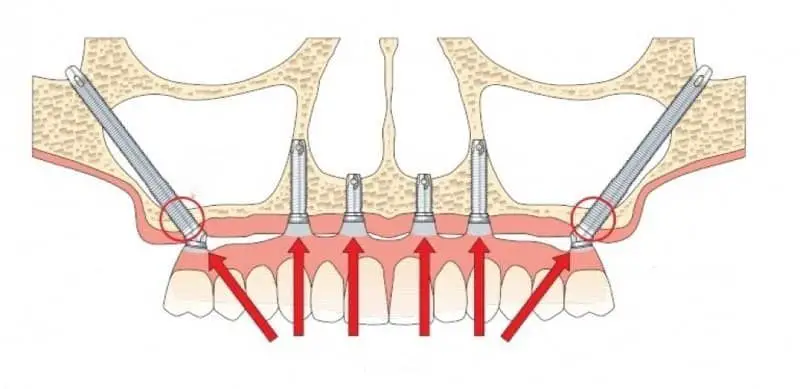
The rarest of them all, zygomatic implants are indicated in individuals with insufficient bone volume posterior to the canines. They are also indicated in people who cannot get a bone graft or a sinus lift surgery to rehabilitate the atrophy of the upper jaw.
This simply means that the bone of their upper jaw has withered so much that little to no volume is left of it.
Apart from that, zygomatic implants can also be given to patients who have experienced failed conventional endosteal implant placement in the past.
Before we proceed to learn about the surgical process involving zygomatic implants, let’s revise a little bit of anatomy.
Zygomatic implants are named so because they are inserted into the zygomatic bone which in layman terms is your cheek bone. Since it articulates with the maxilla or the upper jaw, it is a good sight for an implant.
As zygomatic implant is a way of restoring the upper jaw bone without extensive surgery, before the procedure takes place, a pre-surgical 3D planning with CT or CBCT scans is a must.
Getting the CT scans ensures that all the anatomical locations are located and hence, protected during surgery.
Once that has been taken care of, the patient is called for the implant surgery. During this surgery the first step is to cut the gingiva and separate it from the bone in the area where the maxillary sinus (a connected system of hollow cavities in the skull) is located.
After that, according to the classic protocol, the implants are inserted via the alveolar bone and the maxillary sinus into the zygomatic bone.
This process requires a lot of expertise as the implant is supposed to reach the zygomatic bone without membrane perforation.
The surgical process of getting a zygomatic implant requires a lot of expertise. They are very pricey and the cost may range from $18,000 to $25,000.
The good news is that several long-term prospective studies have found out that zygomatic implants have a high success rate with minimal complications.
Are There Any Downsides To Getting Dental Implants?
Before opting for any surgery you must remember that all surgical operations have complications and it depends whether or not you will experience it.
That being said, even though implants are considered safe, there can be complications. These can range from a simple sinusitis in the case of zygomatic implants to nerve damage during surgery in cases of endosteal implants.
But that rarely ever happens because the surgeons are highly qualified. Therefore, it must be remembered that dental implants aren’t a quick fix.
Infections and swellings post implants are common and can happen to anyone.
You can injure your sinus and nose in cases of maxillary implants, and your major nerves and blood vessels in cases of mandibular implants.
Special Mention: Peri implantitis

Peri implantitis is a complication of an endosteal implant in which the soft tissue and bone surrounding the implant become inflamed. The soft tissues become swollen, indicating the signs of an infection and the bone starts losing itself overtime.
Because peri implantitis has been reported for up to 56% of the times, it is worth mentioning.
However, as peri implantitis is a bacterial infection and presents itself with swelling of the gum tissue at first, it can be well taken care of. The dentist/oral surgeon will put you on antibiotics.
If the situation has already gone hay-wire and bone loss can be seen, your dentist might resort to surgical protocols aiming at regenerating the lost bone and soft tissue.
It has been reported that peri implantitis is mostly an outcome of improper patient selection combined with poor treatment planning and follow-up check-ups.
Apart from that, another downside of an implant would be that they take a lot of time and if you are looking for an easy way out, an implant might not be your answer.
In fact, implants are considered an option solely because of their superiority to other options.
All in all, despite the complications and untimeliness, implants are worth it!
Can Everybody Get A Dental Implant?
Well, technically, yes, everyone can get a dental implant. But there are still certain unfavorable scenarios which may force your dentist to recommend you options other than an implant.
And these can be the deteriorating condition of your jawbone due to heavy smoking, diabetes or any other chronic disease.
With age the bone starts losing its flexibility, the elderly also lose a lot of their bone volume to be able to get an implant.
Although sinus lift, ridge augmentation and bone grafts are all there to the rescue, patients suffering from chronic diseases like diabetes and heart diseases, as well as those who have had radiation therapy to the head and neck area may not be good candidates for either bone grafts or implants.
That’s because even if you do get these surgeries, diseases like uncontrolled diabetes will interfere with wound healing and will also make your bone get back to square one.
Heart diseases are always a risk when a surgery is being carried out, so most dentists would prefer alternate options if you have recently had a heart attack or are taking blood thinners that cannot be stopped.
Patients suffering from trigeminal neuralgia are also advised to not choose implant as a restorative option.
If you are young and healthy with pristine oral hygiene or at least try to, you’ll be a perfect fit.
But even if you are dealing with any of the things mentioned above, there is no harm in consulting an oral and maxillofacial surgeon/ implantologist to be able to get a proper diagnosis.
You never know, maybe you are still a candidate!
Other Techniques If The Above Implants Are Too Dangerous?
Even though implants are the best form of dental prosthesis out there, they are still not everyone’s cup of tea. For some the complications may be very scary, while for others, the cost may be too much.
And when it comes to chronic diseases and radiotherapy, you are not even a candidate.
Are there any alternatives to a dental implant?
My answer to you will be both a Yes, and a No.
Yes because there are a lot of conventional prosthesis available and no because they can’t overtake the countless benefits of getting an implant.
Nonetheless, let’s move forward and look at the options.
Dentures
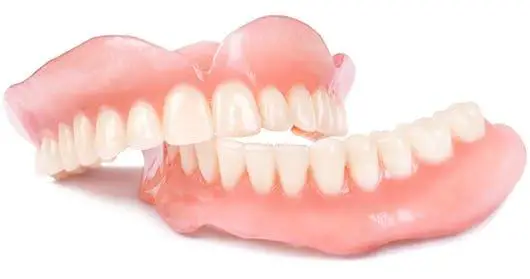
Replacement teeth attached to a pink base made of acrylic are what define dentures. They can even have a metal base attached to them to hold them in the mouth better.
They are usually removable and can either be partial or complete. Partial dentures are used when only a few teeth are supposed to be replaced in the jaw.
As for a complete denture, they are given to people who have lost all their teeth. These dentures are removable and the patient who uses them is advised to take them off at night and keep them clean in order to avoid complications.
Bridge
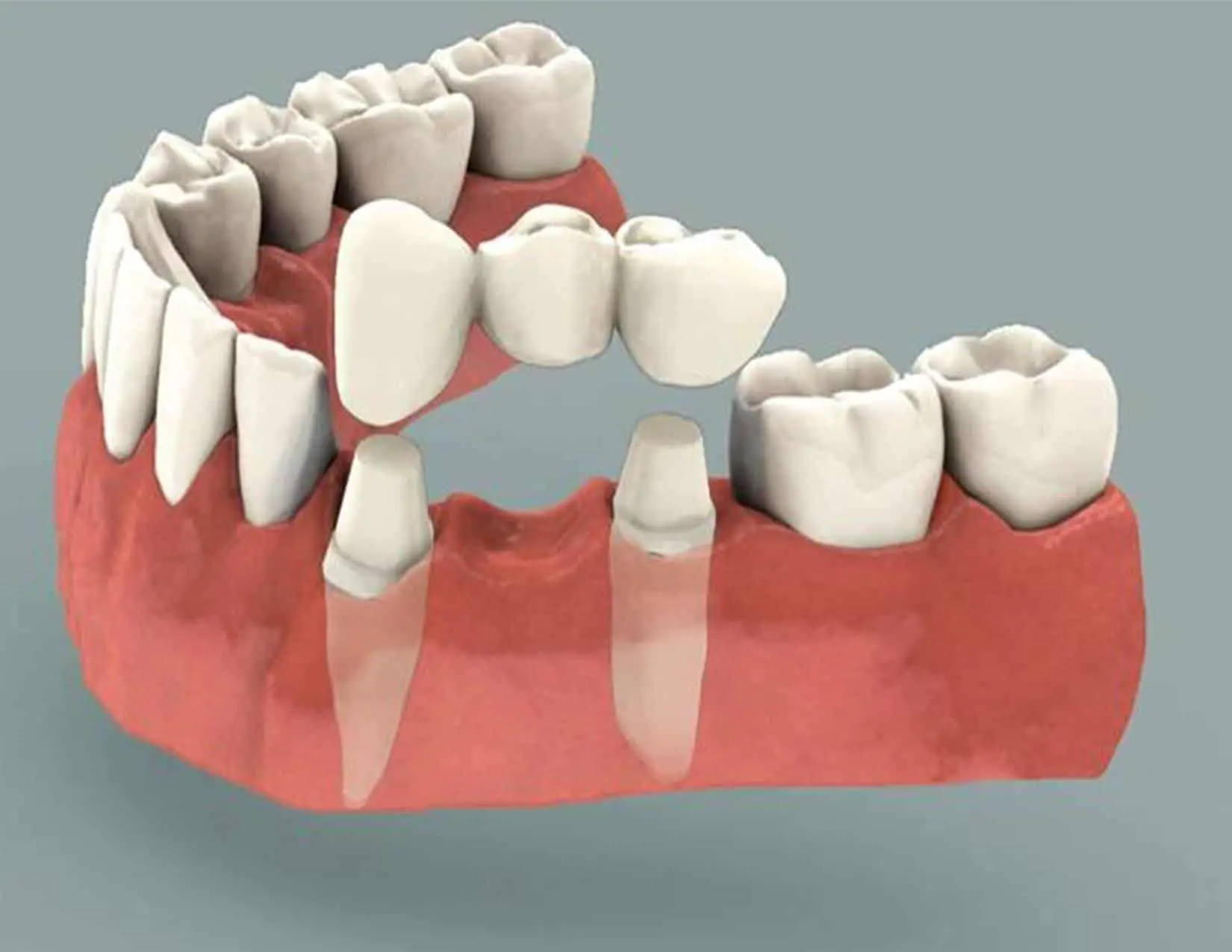
Unlike the London Bridge, your dental bridge will seldom fall down as it is a fixed option. Although successful in many cases, a bridge requires you to have healthy teeth adjacent to the missing tooth/teeth.
If they aren’t healthy or if the condition of your bone isn’t good, getting a dental bridge will most likely not be an option.
It must be noted that during bridge placement, the teeth adjacent to the ones missed are trimmed down and performed root canal therapy (RCT) on to be able to place the bridge and keep it firm.
Summary
Dental implants are hands down a huge success for dental science.
From improving speech and being extremely convenient, to being durable and incredibly supportive, implants have won the dental prosthesis world!
Although endosteal implants aka the conventional implants drilled inside your bone, working to replace the root of your missing tooth are the most popular implants out there.
Dental implants are classified into three different types:
Endosteal implant being one, the other two are sub periosteal and zygomatic implants.
The last two options are only ever looked upon when the conditions are far from healthy. For instance, sub periosteal implants are basically metal plates that sit on your bone under the gums and are not drilled due to unfavorable bone volume.
In case of zygomatic implants, they are inserted directly into the cheek bone in cases of bone loss posterior to the canines.
All of these implants are mostly made up of Titanium and can last for up to 30+ years. They are durable, long lasting and have been a successful approach, hence the popularity.
However, those of us who have metal allergies and cannot get a titanium implant or are suffering from an autoimmune disease, zirconia implants have finally come to the rescue.
They are a much less hassle than titanium implants, are highly aesthetic and there is no need to worry about metal allergies with them.
That being said, like every other surgery, dental implants also come with their own share of complications. from sinusitis to infections to bone loss to nerve injuries.
In certain individuals, their health, habits and age does not allow them to get a dental implant.
In all such cases, dentures that may or may not be removable, and bridges that are always fixed are the two options available.
If you have lost all or most of your teeth, nicely made and perfectly fit dentures may be your answer.
But if you are looking for a fixed prosthesis that looks good too, getting a bridge isn’t a bad idea.
Despite all the benefits, an implant cannot replace your natural teeth so make sure to take care of your oral hygiene and take your dental problems seriously, if any.
Trust me, nothing can come close to your pearly whites!
References
Oxford Handbook of Clinical Dentistry
Contemporary Implant Dentistry
Zygomatic implant procedure and treatment
